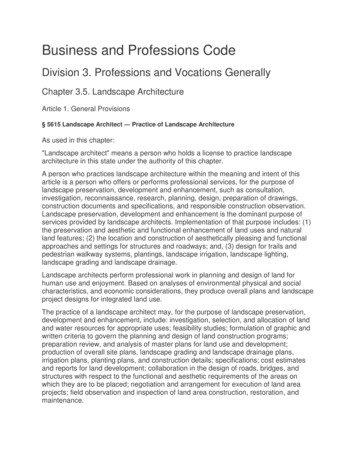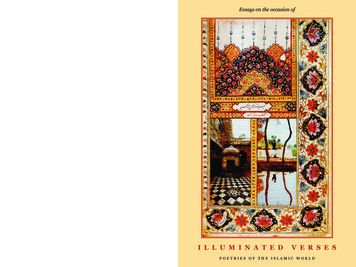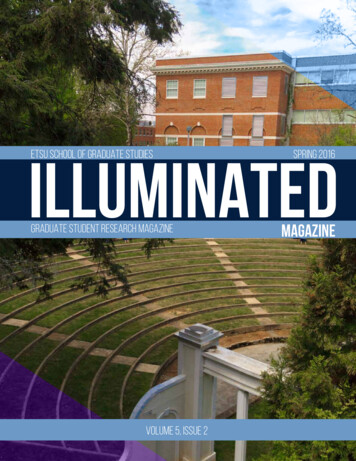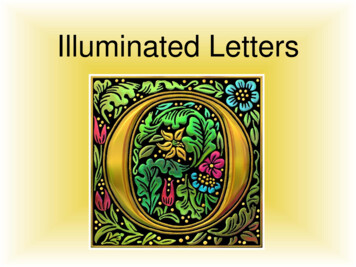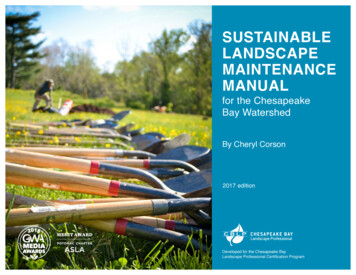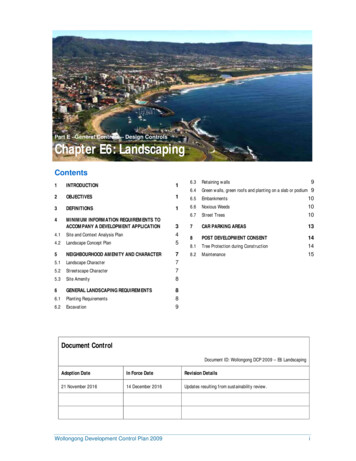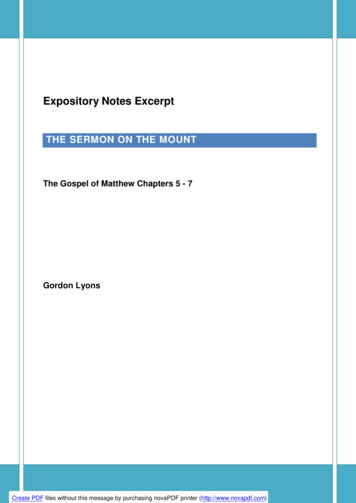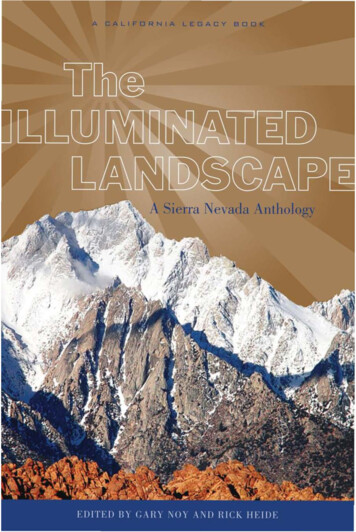
Transcription
A Sierra Nevada AnthologyEdited by Gary Noy and Rick HeideForeword by Robert HannaIllustrations by Joe MedeirosSierra College Press, Rocklin, CaliforniaSanta Clara University, Santa Clara, CaliforniaHeyday Books, Berkeley, California
2010 by Sierra College PressAll rights reserved. No portion of this work may be reproduced or transmitted inany form or by any means, electronic or mechanical, including photocopying andrecording, or by any information storage or retrieval system, without permission inwriting from Heyday Books.“American Woman” by Jordan Fisher Smith is a work of nonfiction based on theexperiences of the author. However, names, places, physical descriptions, and otherparticulars have been changed. For that reason, readers are cautioned that details inthe text do not correspond to real people, places, or events, and any resemblance toreal people is coincidental.Library of Congress Cataloging-in-Publication DataThe illuminated landscape : a Sierra Nevada anthology / edited by Gary Noyand Rick Heide ; foreword by Robert Hanna ; illustrations by Joe Medeiros.p. cm. -- (A California legacy book)ISBN 978-1-59714-128-4 (pbk. : alk. paper)1. Sierra Nevada (Calif. and Nev.)--Description and travel. 2. SierraNevada (Calif. and Nev.)--History--Anecdotes. 3. Travelers’ writings,American--Sierra Nevada (Calif. and Nev.) I. Noy, Gary, 1951- II. Heide,Rick, 1943 F868.S5I55 2010917.94’4--dc222010000435Cover Photograph: Lone Pine Peak, Duane ShoffnerBook Design: Lorraine RathPrinting and Binding: Thomson-Shore, Dexter, MIThis California Legacy book wascopublished by Santa Clara University,Heyday Books, and Sierra College Press.Orders, inquiries, and correspondenceshould be addressed to:Heyday BooksP. O. Box 9145, Berkeley, CA 94709(510) 549-3564, Fax (510) 549-1889www.heydaybooks.comPrinted in the United States of AmericaHeyday Books is committed to preserving ancient forests andnatural resources. We elected to print this title on 30% postconsumer recycled paper, processed chlorine free. As a result,for this printing, we have saved:26 Trees (40' tall and 6-8" diameter)8 Million BTUs of Total Energy2,457 Pounds of Greenhouse Gases11,834 Gallons of Wastewater718 Pounds of Solid WasteHeyday Books made this paper choice because our printer,Thomson-Shore, Inc., is a member of Green Press Initiative,a nonprofit program dedicated to supporting authors, publishers, and suppliers in their efforts to reduce their use of fiberobtained from endangered forests.For more information, visit al impact estimates were made using the Environmental DefensePaper Calculator. For more information visit: www.papercalculator.org.
Foreword by Robert Hanna . ixPreface. xiiChapter 1: Golden Misty Dawn—To 1840The Yokuts, “The Origin of the Sierra Nevadas and Coast Range” . 3The Yokuts, “Prayer for Good Fortune” . 5The Washo, “Weh Hai Ge Ge A” . 6The Konkow, “Old Gambler’s Song”. 7William Joseph, “Football Big-Time”. 8Jack Stewart, “My Mountain”. 10The Maidu, “Mountain Lion and His Children” . 13Pedro Font, “Tuesday, April 2, 1776,” from Font’s Complete Diary . 22Chapter 2: The Opening Eyelids of Dawn—1841–1859Chief Winnemucca, Peter Burnett, and John Bigler. 27John C. Frémont, from Report of the Exploring Expedition to theRocky Mountains in the year 1842, and to Oregon and Californiain the years 1843–’44. 29James D. Houston, from Snow Mountain Passage . 36Edwin Bryant, from What I Saw in California. 45Sarah Eleanor Royce, from A Frontier Lady . 50Bayard Taylor, from Eldorado . 56Lafayette Bunnell, from Discovery of the Yosemite and the IndianWar of 1851 Which Led to That Event . 60Hubert Howe Bancroft, from California Inter Pocula . 65Henry David Thoreau, from The Journal of Henry David Thoreau . 69Olive Burt, from Jim Beckwourth, Crow Chief . 71Bret Harte, “The Luck of Roaring Camp” . 74
Mark Twain, “The Celebrated Jumping Frog of Calaveras County” . 85Ramón Gil Navarro, from Los Chilenos en California . 91Isabel Allende, from Daughter of Fortune. 97John Rollin Ridge, from The Life and Adventures of JoaquínMurieta, the Celebrated California Bandit . 102Jessie Benton Frémont, “My Grizzly Bear” . 107Dame Shirley (Louise Amelia Knapp Smith Clappe), “Letter ofJanuary 27, 1852” . 112Mary Ballou, from I Hear the Hogs in My Kitchen . 116G. Ezra Dane, from Ghost Town. 119James M. Hutchings, from Scenes of Wonder and Curiosity in California. 122Horace Greeley, from An Overland Journey from New York toSan Francisco, in the Summer of 1859 . 125Chapter 3: Always Afternoon—1860–1899Mark Twain, from Roughing It . 135William Brewer, from Up and Down California in 1860–1864 . 142Clarence King, from Mountaineering in the Sierra Nevada. 145Maxine Hong Kingston, from China Men . 150Walt Whitman, from “Passage to India” . 155Robert Louis Stevenson, from Across the Plains. 157Grace Greenwood, “Eight Days in the Yosemite”. 159Joseph LeConte, from A Journal of Ramblings through theHigh Sierra of California . 163John Muir, “A Wind Storm in the Forests of the Yuba” . 165Kevin Starr, from Americans and the California Dream, 1850–1915 . 171Ella Sterling Cummins Mighels, “Portrait of a California Girl” . 179Mary Hallock Foote, from A Victorian Gentlewoman in the Far West . 183Frank Norris, from McTeague. 186Jack London, “All Gold Cañon” . 193Chapter 4: Shadows in the Alpenglow—1900–1950Mary Austin, from The Land of Little Rain. 213Marie Potts, from The Northern Maidu. 219Joaquin Miller, “Yosemite” . 221Marc Reisner, from A Dangerous Place . 223John Muir, from The Yosemite. 228Chiura Obata, newspaper series, 1928 . 236Ansel Adams, from Sierra Club Bulletin, February 1932. 238Kenneth Rexroth, “Blues” . 240Sally Carrighar, from One Day on Beetle Rock. 242Jeanne Wakatsuki Houston and James D. Houston,from Farewell to Manzanar. 246 i
Chapter 5: Twilight of the Dawn—1951–1990Jack Kerouac, from The Dharma Bums. 255Gary Snyder, “What Happened Here Before” . 260William Everson, “Bride of the Bear” . 264Bill Hotchkiss, “Indian Summer” . 268David Brower, from Gentle Wilderness . 270Alice Adams, “Favors” . 276Bev Ortiz, from It Will Live Forever. 289Jordan Fisher Smith, from Nature Noir. 302Wallace Stegner, from Angle of Repose . 309Chapter 6: Quiet-Colored End of E ening—1991–PresentTom Knudson, from The Sierra in Peril. 323Wendy Rose, “Questions for a Miwok Uncle: Ahwahneechee Man” . 331Janice Gould, “Late Summer in the Sierra”. 333Gary Snyder, from A Place in Space . 335T. Coraghessan Boyle, “Sitting on Top of the World”. 338Daniel Duane, from Lighting Out . 354Ann Zwinger, from Yosemite. 361Alejandro Murguía, “Josefa of Downieville: The Obscure Lifeand Notable Death of a Chicana in Gold Rush California” . 368Sylvia Ross, “Tribal Identity Grade Three”. 384David Beesley, from Crow’s Range . 386David Gilligan, from The Secret Sierra . 391Ishmael Reed, “Holiday Train to Reno” . 394Maria Melendez, “Clan Markings, Stanislaus National Forest, 1980s” . 397Jordan Fisher Smith, “American Woman” . 400Gary Snyder, “The Ark of the Sierra” . 412Joe Medeiros, “The Power of Trees” . 419Sources and Permissions. 429Author Index. 437Acknowledgments . 439About the Editors . 444 ii
Robert HannaIwas my great-great-grandfather. In 1906 his daughter Wanda marriedn my veins courses the blood of John Muir. The famous conservationistThomas Hanna, my great-grandfather.Along with the blood of the Muir family, the Hanna family, andthe blood of California, the spirit of the Sierra Nevada also exists inmy heart. It is part of my legacy, our legacy, of the mighty mountainrange about which my great-great-grandfather spoke and wrotewith such eloquence that his words live on—now for more than onehundred years.In my family’s possession is a crystal inkwell used by John Muir inhis writing quarters. This is the inkwell he used when writing most ofthe words that helped shine light on his favorite place in the world—the magnificent Sierra Nevada. When I hold his inkwell in my handsand feel its glassy smoothness, its cold, inanimate contents, I can’t helpbut think of how Muir turned lifeless ink into multidimensional storiesand palpable visions of experiences in his beloved mountains. Theseinclude an encounter with a Sierra bear, windstorms while riding atopa tall Douglas fir, and glacier hikes in Alaska with the wee dog Stickeen.His words released a flood of memories and brought to life the fondnessand passion that so many of us have also experienced in wilderness yetfind so hard to express.My affiliations to John Muir were downplayed in my youth, but Icame to know more about Mr. Muir later in my life. I’d thought thatix
our family’s cabin, nestled in a remote glacial gorge along the Sierra’ssteep eastern slope, was simply an expression of domestic frugality—no modern conveniences by design, no waste of resources, and no needfor contemporary contrivances. But I learned that this old cabin wasan extension of Muir himself. Purposely spartan, it was to be a refugefor the family, a method for getting away from the city. My Uncle Timencouraged me to look around. He said that here on the mountaintopwe would never be closer to God than at that very moment. My visits tonearby Yosemite were filled with visions of the awe and majesty of themountains, but I remember only peaceful, calming feelings from thesechildhood outings. Such intimate experiences with nature connectedme with the Muir in my blood, even though I didn’t know it then.Through gatherings at various colleges and institutes, I havethoroughly enjoyed becoming reconnected to the passion that this manhad for the Sierra—and for all wild things and wild places. I’ve attendedscores of celebrations, anniversaries, and events recognizing the famousmountaineer, and over time I’ve endeavored to learn more about theman and his tireless efforts to promote wilderness preservation. I havebegun to feel the passion and the purpose that he had for defendingcountless creatures and wild places that desperately needed protectionand yet had no voice.Not long ago I participated in a semester-long class at Sierra Collegein which Muir’s “Range of Light” was the center of attention. It wasan interdisciplinary course on the Sierra Nevada, led by professors JoeMedeiros and Gary Noy, and they invited us to examine, from myriadperspectives, this massive bioregion and all that it represented to themillions who used it, lived in it, worked in it, and loved it. We discussedthe Sierra’s natural history, its human history, how the range has beeninterpreted, and how it has been misused, as well as how to conserveit and keep it healthy for future generations. The Sierra College classhelped me reawaken and nourish those stubborn Scottish blood cellsflowing through my veins, and reconnect with a legacy that my great great-grandfather started.In the pages that follow are the stories and observations of writerswho, like Muir, have been transfixed by the Sierra Nevada. The scopeof the writings is as breathtaking as the range itself. From their voiceswe hear of the profound connection of customs and landscape. Weconsider the extraordinary transformation that occurs with the arrivalof European culture and the overwhelming impact of the CaliforniaGold Rush. We read beautiful descriptions of the Sierra along withx
concerns about its future. We experience heart-pounding adventureand tragedy. We see how this remarkable environment can influenceour perspective, both physical and emotional. We encounter the powerof the written word to enhance the splendor of a spectacular geographyand of our understanding of ourselves.This varied collection, so thoroughly exploring the history, culture,natural landscape, and issues confronting the Sierra Nevada, comesat a critical moment. My great-great-grandfather’s beloved Range ofLight is threatened even more than in days gone by. Rapid populationgrowth and unchecked development apply increased pressure on thelimited resources. Our understanding (or, perhaps more accurately, ourmisunderstanding) of forests and forest health remain as contentiousas ever. The specter of climate change looms large, fueling worrisomespeculation for the future of the snowpack upon which many millionsare dependent for our ever-growing thirst for water. It seems the verycharacter of the Sierra Nevada is in danger. This collection reminds usof the remarkable appeal and value of the Sierra Nevada, and what canbe lost if we do not act.Just as Muir’s impassioned writings inspired early efforts to use theland wisely, so too are new generations of writers inspiring, energizing,and challenging us with their words. Each of these authors has uniquetalents, but they share the same essence. Everyone has a voice. Everyonecan make a difference. Any individual has the power to become a JohnMuir. The spirit is within each of us, waiting to be set free. It is a specialplace, as he said, where one can “climb the mountains and get theirgood tidings. Nature’s peace will flow into you as sunshine flows intotrees. The winds will blow their own freshness into you, and the stormstheir energy, while cares will drop off like autumn leaves.”xi
Everything has a beginning.For the Sierra Nevada, the genesis is found in the place itself—a25,000-square-mile wondrous construction with granite cliffs as walls,wildflowers as carpet, and a star-studded sky as the ceiling.From the largest tree to the tiniest insect, the mountain range exhibitsthe vast spectrum of life and the processes that influence existence.Sculpted granite, roaring cascades, towering forests, wildflower-drapedmeadows, thunderous storms, thousands of windswept crystalline lakesand streams, all of this inhabits the region and haunts our dreams. It is aland browsed by mule deer and bighorn sheep, roamed by the mountainlion, guarded by the golden eagle, and enchanted by the flash of arainbow trout. Yet we can only appreciate this beauty, this complexity,this interdependence with the aid of the range’s extraordinary qualityof light.This special light is unique to the Sierra Nevada. It is a light thatenvelops the trees, the peaks, and the creatures, bathing each subtletexture with a warm glow and creating a splendid illuminated landscape.As John Muir rhapsodized in his classic 1912 book The Yosemite, “Itseemed to me that the Sierra should be called, not the Nevada or SnowyRange, but the Range of Light. And after ten years of wandering andwondering in the heart of it, rejoicing in its glorious floods of light,the white beams of the morning streaming through the passes, thenoonday radiance on the crystal rocks, the flush of the alpenglow, andthe irised spray of countless waterfalls, it still seems above all others theRange of Light.” These words still ring true today, as anyone who hasencountered this phenomenon can attest.xii
From the beginning, the Sierra Nevada has inspired artists. Whetherone’s discovery was eons ago or just yesterday, the remarkable diversityand breathtaking majesty of the range captivates the imagination andstirs the soul. The powerful conjunction of the ageless splendor ofits landforms, the continual metamorphosis of its human agents ofchange, and the startling variety of the Sierra Nevada natural world areendless creative resources for the camera, the brush, and the pen. Thevitality and grandeur of the Sierra Nevada offers no greater palette forthe muse.The narrative of the Sierra Nevada is a study in contrasts. Equal partsheroic effort and tragic consequence, it is a legacy of golden dreamsand shattered hopes, feverish exploitation and hard-won preservation.It is an account of constant commemoration and the promise of aclean slate. It is a heritage of celebrated racial diversity and shamefuldiscrimination.A major theme of Sierra Nevada history is invention and re-inventionin a land apart. In short, it is a story as old as the sunset and as new asthe dawn—the eternal human drama enacted on a monumental stage.In this anthology we present accounts of the remarkable SierraNevada experience. From the origin myths and social rituals of the firstinhabitants, to the first impressions and dreams of those who wouldlater dominate, to the breathless and frequently moving descriptions ofboth visitors and settlers, to the often sad transitions that mark culturalchange, the Sierra Nevada story unfolds. And it is with this originthat we realize an immutable truth: the Sierra Nevada illuminates ourexistence. It shines a light on majestic stretches of unmatched beauty,but also on an understanding of our place in the world.The readings collected here show remarkable range as well. Reportsrequiring copious scientific detail stand beside gentle poetic lyricism,and the voices of men, women, the young, the old, the outsider, thenative, the victim, and the victimizer are all heard. We are honoredthat three authors—Joe Medeiros, Maria Melendez, and Jordan FisherSmith—have written works especially for this anthology. There arewords of inner turmoil and grandiose claims, of personal doubt andcultural exultation, of heartfelt rejoicing and bewildered resignation, ofthe struggle to survive and the will to understand, and of wondermentand worry. These are the thoughts of people grappling with a new realityand struggling to make sense of the situation. These are bulletins fromxiii
the heart and mind, sometimes bracketed with wrenching uneasinessin the gut.The geography presented in The Illuminated Landscape encompassesthe entire Sierra Nevada region. The Sierra Nevada is one mountainrange, 430 miles long and 40 to 80 miles wide. The anthology embracesnot only the majestic granite spine of the range but its western foothillsand eastern escarpment as well. California’s Gold Country or MotherLode, as part of this same bioregion, is another important part of thebook. We also include neighboring areas, such as the high desertstretches of eastern California and western Nevada.As with any anthology, the selection process was a difficult one.There are so many possibilities, and making the ultimate decision as towhat should be included was daunting. As a result, one of your favoriteexcerpts may be missing; the good news is that it can always be addedto another edition of this compilation.It is our wish that this collection will serve as a record of the awethat this magnificent range has inspired. But we also hope that it willserve as a reminder that the Sierra Nevada is a living organism thatis constantly beset by environmental and social challenges. A goal ofthis anthology is to raise awareness of this spectacular setting and tocreate an appreciation of what is at risk in the Sierra Nevada today.Since the dawn of history, the Range of Light has provided importantresources and an invaluable refuge for our spirits. As the sanctuarycomes under attack—whether from population pressures, climatechange, or some other danger—we have a responsibility to protect thisbreathtaking mountain cathedral. The stakes are high and the roadwill require thoughtful planning and complete dedication, but if wesucceed, the reward will be profound: the Sierra Nevada will remainthe extraordinary illuminated landscape for generations to come.Let’s head on up the trail.Gary NoyRick Heidexi
The Illuminated Landscape: A Sierra Nevada Anthology“This anthology of Sierra writings stands tall.”-- Sam McManis, Sacramento Bee“The Illuminated Landscape: A Sierra Nevada Anthology brings together the bestliterature about our own back yard .As a primer, reference or call topreservation, depending on the reader’s perspective, The Illuminated Landscapedelivers up history with a look ahead to a future Sierra.”-- Pamela Biery, Sacramento News and ReviewPerhaps because California holds so many fascinating stories and naturalwonders, the physical and cultural landscapes of our Sierra Nevada rarelyreceive the focused attention they deserve. But thanks to this inspired collectionof readings, readers can rediscover the wonders of these mountains as well asthe very human stories embedded in them. Historians Noy and Heideundertook this project with characteristic care, intelligence, and enthusiasm, andthey don’t disappoint. Gathered here are not only some familiar Sierrachroniclers—James Hutchings, Dame Shirley, Bret Harte, John Muir, AnselAdams, Gary Snyder—but also voices that illuminate the breadth of humanexperiences with the “range of light”—Jack Stewart, Ramon Gil Navarro, MaxineHong Kingston. Reading this collection is to be reminded that the landscapes ofthe Sierra have awed, nurtured, terrified, enriched, beguiled, and inspiredmillions, denizens and visitors alike. Care must be taken that they will continueto do so for future generations. Thanks to the editors and Heyday Books, theSierra Nevada is newly illuminated for all.-- Dr. Patrick Ettinger,Associate Professor, Department of History, California StateUniversity, SacramentoThis is a remarkable anthology, taking the reader chronologically from the dawnof time when Yokuts, Washo and the Maidu’s passed on their first memories oftheir respective worlds to environmental issues of today. The most celebratedwriting about California’s Sierra Nevada by scientists, journalists, diarists, artists,poets, and popular writers is compressed into this neat tome. Familiar authorssuch as Sarah Royce, Bret Harte, Louise Clappe (Dame Shirley), and John Muirare paired with other less well known voices by romantics and realists who havegone to the mountains and returned, putting their stories and impressions intoprint. Carefully chosen by the editors, the entries will serve the serious studentof history, literature and the environment, as well as the general publicinterested in an overview of this most unique geographical region within thestate. Truly interdisciplinary, this book belongs on every bookshelf of the bestof-the-best of Californiana.-- Dr. William R. Swagerty,Director, John Muir Center, University of the Pacific
California is a composite of several distinct locales, none more remarkable thanthe Sierra Nevada, the state's spine. On the sublime peaks or in the secretcanyons of the Sierra, in the luminosity its alpine afternoons or in the star-foggedclarity of its nights, people are moved to not only examine what great nature hascreated, but also to gaze inward at their own natures. The writers in thisexcellent collection move in both directions and capture not only the beauty butalso the wisdom offered by these mountains, what they evoke in us. Thetraditional Yokuts chant acknowledged, "My words are tied in one with the greatmountains/ With the great rocks/ With the great trees." The selections in thisfine collection demonstrate the universality of that ancient prayer.-- Gerald Haslam,best-selling author of Coming of Age in California and Workin’ ManBluesBrilliantly assembled and introduced, this first anthology of Sierra Nevadawritings stands as a landmark publication. Native Americans, explorers,missionaries, gold seekers, governors, mountain climbers, naturalists,environmentalists, essayists, and poets are all represented with their powerfuldescriptions and compelling insights into California’s grand and gloriousmountain range.-- Gary F. Kurutz,Author, Bibliographer and Curator of Special Collections,California State Library.It is indeed challenging to tell the story of the Sierra Nevada through thewritten word. However, The Illuminated Landscape does so with a remarkablediversity of perspective, nearly equal to the biological diversity of the place itself.This mountain range is a magnificent place. Whether you discovered itthrough a firsthand visit, the words of Muir or the lens of Adams, for most usthis place leaves an indelible mark. Its beauty, its majesty, its remarkable terraininspires awe.Beyond its beauty, the Sierra Nevada provides nearly two-thirds of thestate’s water. It is home to hundreds of plant and animal species, not to mentionmore than 600,000 human residents. It is one our state’s most prized areas torecreate, vacation and to find solace.For those of us with an “official” responsibility to protect and steward thisplace, the duty is both sobering and inspiring. Today, the region deals with itslatest set of challenges – catastrophic fire, climate change, economic sustainabilityand population growth to name a few. Underlying these challenges is the clearurban/rural divide that exists in California and affects public policy andinvestment. Most Californians have not had the chance to visit the Sierra andwitness the “light” for themselves. Despite the fact that millions of our residentsrely on the Sierra for their water, most have no connection to the source of theirlifeblood. p
The illuminated landscape : a Sierra Nevada anthology / edited by Gary Noy and Rick Heide ; foreword by Robert Hanna ; illustrations by Joe Medeiros. p. cm. -- (A California legacy book) ISBN 978-1-59714-128-4



